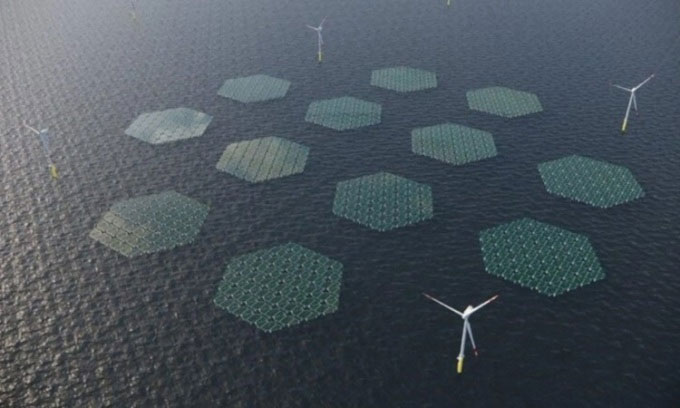The Netherlands built the world's largest floating offshore solar farm
Dutch company Solar Duck is preparing to build the world's largest floating solar power plant with a capacity of 5 MW .
The construction process of a 5 megawatt (MW) offshore floating solar power plant begins with the stages of design, construction and facility introduction, Interesting Engineering reported on March 5. Solar Duck, a Dutch company, provides technology for the factory.

Combined with wind turbines, solar panels placed on water will help increase clean electricity output. (Photo: SolarDuck).
SolarDuck embarked on a $9.1 million project to build the world's largest offshore floating solar power project (OFS). The project will be incorporated, licensed and located within the OranjeWind wind farm on the west coast of the Netherlands. Before construction of the facility begins, a consortium called Nautical SUNRISE will conduct a study of the project's components, ensuring their reliability, long-term performance, stability and productivity. floating machine. Depending on the research results, authorities will draw a detailed plan to address challenges and promote project commercialization.
In addition, the alliance will also conduct a sustainability assessment of the project and consider factors such as environmental impact and full operating cycle. According to Don Hoogendoorn, chief technology officer at SolarDuck, the project will allow the company to better understand the ecological and safety impact of its design.
As countries seek to cut fossil fuels, energy solutions based on wind and solar power are being rapidly installed. Although the gradual decrease in electricity prices from these technologies is a good sign, low energy conversion rates are still a big problem. Both wind and solar power plants require large land areas to exploit large amounts of electricity for efficient conversion.
The land area on Earth is limited and used for a variety of purposes, from housing and agriculture to industrial parks. As a result, wind farms have moved offshore to build larger turbines and exploit higher wind speeds, thereby producing more clean electricity. Similarly, solar farms also need to move to the water. Covering canals with solar cells may be a good idea in areas where water is scarce. But rivers and lakes only cover 0.2% of the planet's surface. Furthermore, rivers are used for inland navigation, so installing solar panels could affect the current system.
In contrast, 71% of the planet's surface is covered by ocean water, providing the opportunity to build energy harvesting facilities using abundant sunlight. The company SolarDuck is interested in installing solar farms in an area called the Sun Belt. Areas like the Caribbean, Japan, Korea, even Oman, are rich in sunshine but low in wind. With limited land area, large-scale energy infrastructure becomes too costly in those places. However, the surrounding sea areas are ideal for locating offshore floating power plants. This will help many countries reduce their dependence on diesel or natural gas and reduce carbon.
- Europe's largest floating solar farm is about to operate
- Sirindhorn - The world's largest floating solar farm
- Japan built the world's largest wind farm
- China built the world's largest floating solar power plant
- New technology: 'Solar Island' is both absorbing CO2 and creating methanol as fuel
- Anh: Start wind farm project
- Offshore wind power: Potential in the future
- Inauguration of the world's largest wind farm
- The largest green farm in the world in the heart of magnificent Paris
- Solar power plant floating in Japan
- Started construction of the world's largest floating solar power plant
- Canada will have a solar farm
 Norway built the world's tallest wooden tower
Norway built the world's tallest wooden tower Kremlin
Kremlin Ashurbanipal: The oldest royal library in the world
Ashurbanipal: The oldest royal library in the world Decoding the thousand-year construction of Qin Shihuang shocked the world
Decoding the thousand-year construction of Qin Shihuang shocked the world